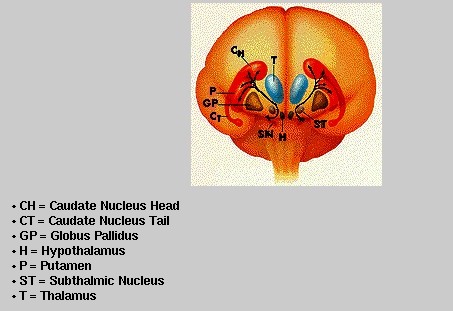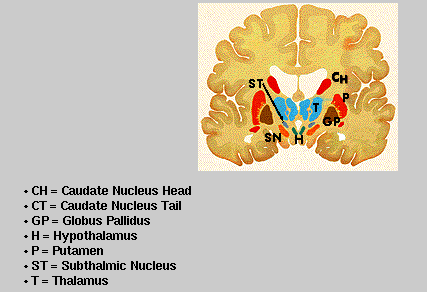 Return to Table of Contents
Return to Table of Contents
The modern history of Parkinsonism begun in 1817 when James Parkinson published a small monograph entitled "An Essay on the Shaking Palsy". In its pages the clear description of the condition now called Parkinson's disease (PD) were found. PD, is characterized by a loss of nigrostriatal neurons, is usually a disorder of progressive disability. While additional nueronal systems are altered in idiopathic PD, the changes most closely linked to clinical symptomatology is the impared region of the brain known as the substantia nigra.The substantia nigr's pigmented cells synapse with cells in the corpus striatum, and release dopamine. These neurons are important because they produce a substance called dopamine. Dopamine is a chemical "messenger" in the brain that helps the nervous system control muscle activity. When these neurons are destroyed dopamine is not produced at the normal rate. After it is produced, dopamine is broken down by an enzyme in the body called monoamine oxidase-B (MAO-B). This breakdown reduces the dopamine supply further An abnormally low supply of dopamine causes Parkinson's symptoms to appear.
Parkinson's Disease affects 1.5 million Americans about 50,000 in US, with 36,000 new cases recorded each year. Some studies show that African-Americans and Asians are less likely than whites to develop Parkinson's Disease Onset of idiopathicc PD generally occures after age 40, affecting 1% of the populaion over 60. PD appears to be more common in men, mostly non-snokers, and tend to be progressive over one to two decades, leading to ultimate incapacity and death (McGoon, 1994).
General symptoms associated with PD include: stiffness, tremor, bradykinesia marked by slowness and poverty of movement, hypokinesia charcterized by the slowing of muscular movements with decreasing range of motion, difficulty with balance and walking, postural deformity, autonomic dysfunctions such as constipation and retention, and sensory complaints such as pain, numbness, tingling, and sustained musle spasms. Also, refer to Bradykinesia for more information.
Refer to The Parkinson's Web #1 and Parkinson's Web #2 for more information.
STAGE ONE:
2. Symptoms mild
3. Symptoms inconvenient but not disabling
4. Usually presents with tremor of one limb
5. Friends have noticed changes in posture,locomotion and facial expression
STAGE TWO:
1. Symptoms are bilateral
2. Minimal disability
3. Posture and gait affected
STAGE THREE:
1. Significant slowing of body movements
2. Early impairment of equilibrium on walking or standing
3. Generalized dysfunction that is moderately severe
STAGE FOUR:
1. Severe symptoms
2. Can still walk to a limited extent
3. Rigidity and bradykinesia
4. No longer able to live alone
5. Tremor may be less than earlier stages
STAGE FIVE:
1. Cachectic stage
2. Invalidism complete
3. Cannot stand or walk
4. Requires constant nursing care
These stages were classified according "Hoehn and Yahr". For more detailed information and for a complete list see Functional and Stereotactic Neurosurgery.
We need to picture the brain as the body's communications system in order to understand who brain functions during PD.
 It receives stimuli from the sense organs and, in return, sends messages to various parts of the body. These messages transmit instruction which govern specific bodily functions. If, in any way, there is an interference in this transmittal process, then, like a damaged communications system, some breakdown occurs.
It receives stimuli from the sense organs and, in return, sends messages to various parts of the body. These messages transmit instruction which govern specific bodily functions. If, in any way, there is an interference in this transmittal process, then, like a damaged communications system, some breakdown occurs.
 PD is associated predominantly with two areas of the brain: the substantia nigra and the striatum (the caudate nucleus and putamen). The substantia nigra (meaning "black substance") derives its name from its many pigmented cells. These cells contain neuromelanin, a pigment that resembles melanin (the pigment found in skin).
PD is associated predominantly with two areas of the brain: the substantia nigra and the striatum (the caudate nucleus and putamen). The substantia nigra (meaning "black substance") derives its name from its many pigmented cells. These cells contain neuromelanin, a pigment that resembles melanin (the pigment found in skin). The substantia nigra's pigmented cells connect ("synapse") with cells in another area of the brain, the striatum, which controls movement, balance, and walking. Messages pass between the cells in the substantia nigra and the cells in the striatum through the aid of dopamine, a chemical substance which acts as a transmitter. Dopamine is one of several such chemical transmitters found in the brain. It is the most important chemical transmitter governing the activity of the substantia nigra and the striatum, and, therefore, of movement, balance, and walking.
The substantia nigra's pigmented cells connect ("synapse") with cells in another area of the brain, the striatum, which controls movement, balance, and walking. Messages pass between the cells in the substantia nigra and the cells in the striatum through the aid of dopamine, a chemical substance which acts as a transmitter. Dopamine is one of several such chemical transmitters found in the brain. It is the most important chemical transmitter governing the activity of the substantia nigra and the striatum, and, therefore, of movement, balance, and walking.
In PD, many of the cells of the substantia nigra, and a few cells in the striatum are damaged. These damaged cells may contain pink staining spheres called Lewy bodies. The Lewy body is a marker for PD. Why the Lewy body appears, and how it is involved in damaging cells is not known.
Paralleling the degree of cell loss in the substantia nigra is a loss of dopamine in the striatum. Loss of approximately 80 percent of the substantia nigra's pigmented cells and 80 percent of the striatum's dopamine content result in the appearance of the PD symptoms. For more detailed information and detailed illustration refer to "Chemical Changes in Brain" .
 This picture showes the dopamine effect on basal ganglia activity. It also showes the direct and indirict pathways of dopamine on nerve cells.
This picture showes the dopamine effect on basal ganglia activity. It also showes the direct and indirict pathways of dopamine on nerve cells.
In order to see the describtion of the diagram click here..
This picture showes the Inside a Nerve Ending In the Striatum: and The Site of Parkinson's Disease .
 This also showes the steps in the process of transmitting an impulse from one nerve cell to another.
This also showes the steps in the process of transmitting an impulse from one nerve cell to another.
1. dopamine production
2. dopamine storage
3. dopamine release
4. dopamine receptors
5. dopamine re-uptake
6. dopamine breakdown
For more detailed information and detailed illustration refer to "Activity of brain in PD".
For more information on Levadopa treatement see "Levadopa Sespention"
For general information on treatments click here
1. Glaucoma
2. Heart Disease
3. High Blood Preasure
4. Stomach, intestinal Disease
5. Bladder conditon
6. Orthopedic Condition
7. Cancer
For more detailed describtion for each category click here..
For Psychosocial Factors refer here
For Iinfo on A Primer on PD Medications refer here
For more info on PD research click here
For PD patients input on drugs and treatement refer Personal info
The following has been added by the Electronic Desktop Project:
If you are an educator who is using our NEXTSTEP or virtual applications in the classroom, we would especially like to hear from you. Let us know what you are doing and how it is working out. Continued support for this project will depend on its impact in science education.
If you are an educator who is interested in making use of our NEXTSTEP or virtual applications, please let us know how we can help.
Conditions Influencing Treatment
Miscellaneous
Other Organizations and Contacts
Please take a few minutes to send us your comments and suggestions. We read every message and try to respond promptly to questions. Your feedback will help us improve our project. Contact Us
Contact UsOther Places To Go
 Return to the Electronic Desktop Project home page
Return to the Electronic Desktop Project home page![]() Check out the WWW Virtual Application Catalog from the EDP
Check out the WWW Virtual Application Catalog from the EDP Check out the NEXTSTEP Application Catalog from the EDP
Check out the NEXTSTEP Application Catalog from the EDP Visit the home page for California State University, Los Angeles
Visit the home page for California State University, Los Angeles